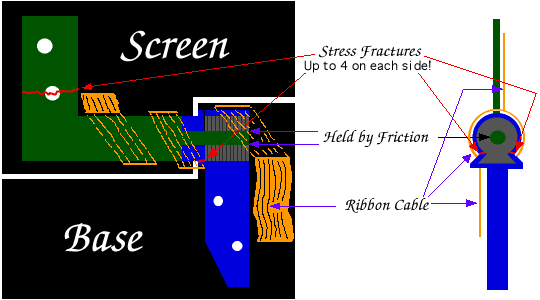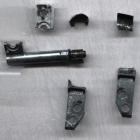

This is a legacy page and remains here for historical reference.
The PowerBook G3 Series Hinge Problem
Update: On December 1, 2000, I bought a new (albeit end-of-life) Pismo to replace my first Powerbook G3 (Wallstreet) because of the hinge problem and the AC Power adaptor breaking. I have treated this laptop with the utmost care. Despite that, the hinges still broke. I called Apple and they say they will repair it under my Applecare Protection Plan coverage. I have the mailer box and will be sending it in on July 31, 2003. I'll let you know how things go.I am overwhelmed and gratified by the traffic this page has generated. I am also a bit dismayed by some of the comments posted on macnn.com (especially this one). Those who believe that I and others are whining and expecting too much from our laptops and Apple clearly have never experienced this problem and do not understand it. My screen physically separated from my Powerbook! The hinge defect, and the other common problem of the power adapter failing, will render a $5000 machine useless. Please read this page and the comments on the links at the bottom before writing this issue off as "whining."
My Powerbook, like hundreds of others, has suffered premature failure of the hinge (AKA clutch) which holds the LCD screen in a vertical, and thus useful, position. I have disassembled and analyzed the hinge and clutch. Below is a simple schematic of the relevant parts.

The above is a schematic of the left side clutch mechanism
The left and right clutches are identical, just rotated 180 degrees from each other.
Terminology
For clarity, I will use the term "clutch" when referring specifically to the friction mechanism and its immediately adjact components, and "hinge" when referring to the entire mechanism, which includes in particular the structural elements which hold the clutch together and anchor it to the screen and base.The friction mechanism
The above schematic requires a minimum of description. The blue and green are aluminum parts. The keyhole shaped gray pieces are metal wafers, about 8 in total (per hinge) and each about 1mm thick. They are coated with a thick oil. The green stem fits tightly in the central holes of the wafers and is where the friction exists which holds up the screen. The green stem rotates in the central hole when the Powerbook is opened and closed; the wafers do not rotate, being fixed in position by their shape. The friction mechanism is NOT where the failure happens.Failure happens in the structural elements
 The failure (and by failure I mean broken and separated parts) happens in the
non-moving, structural parts which hold the friction mechanism together. There
are 4 separate places per hinge (and there are 2 hinges per laptop) which can
fail. One or two stress fractures and you have a loose screen. Three or more, and
your screen may begin separating from the base. Note that the 2 fracture points
seen in the side view are different from the 2 shown in the frontal view.
The failure (and by failure I mean broken and separated parts) happens in the
non-moving, structural parts which hold the friction mechanism together. There
are 4 separate places per hinge (and there are 2 hinges per laptop) which can
fail. One or two stress fractures and you have a loose screen. Three or more, and
your screen may begin separating from the base. Note that the 2 fracture points
seen in the side view are different from the 2 shown in the frontal view.Collateral damage to the video cable
When failure happens in the 2 spots seen on the side view, a hemicylindrical piece of metal will begin floating freely in the area of the clutch. As you can see, there is a ribbon cable (which carries the video signal) wrapped around the clutch; when the hemi-cylinder detaches, its sharp edges may cut or wear on the ribbon cable, resulting in additional damage, expense, and loss of function.Obtaining and installing new hinges
The part number of the hinge is #922-3368. I am told they come 5 to a pack. Apple will not sell them to end users, and they appear to be unobtainable through retail channels, either due to unavailability, unwillingness, or on direct orders from Apple.If you could obtain 2 hinges, replacing them would take about an hour or two for mechanically inclined, slightly brave owners of crippled laptops. You will need a torx T-8 screwdriver, and a flathead screwdriver (to pry the screen section apart). You may also want to remove the keyboard in order to disconnect the video ribbon cables from the logic board.
While you are disassembling your Powerbook, you may want to inspect the sound card (which contains the AC power adapter plug) and look for stress cracks in the solder connections to the power adapter. You will need to remove the card to see any cracks(look carefully, they are hairline). If you see cracks , failure of this component is imminent. Fortunately, this is easily fixed with a bit of electrical solder.
Take-home points
Based on my observations and communications, there are several key points to consider:
|
|
For more information
http://www.OCF.Berkeley.EDU/~kenao/unhinged/http://www.macopinion.com/columns/roadwarrior/01/07/03/
http://www.jeffpollard.net/hinge_fix/
G3 hinge group on Yahoo!










© 1997-2022 Jeffrey W Baumann dba LinkedResources. All Rights Reserved. Last Updated December 28, 2021.
